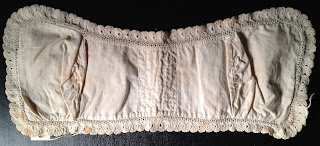This summer, I've been interning at LancasterHistory.org. While, yes, it is a website, it is also the name of the Lancaster County Historical Society and President Buchanan's Wheatland. Recently gifted with a beautiful addition to their original building by a National Endowment for the Humanities (NEH) grant, the historical society has really leaped forward in today's age with a green building and many technological improvements such as better cases for displaying quilts and touchscreens so visitors can learn more about individual objects on display.
 |
| The exterior of the new building. |
 |
| The interior of the new building. |
So what have I been up to here? As I described to Pauline Eversmann, our Museum Studies internship director, ... pretty much everything and the kitchen sink! My biggest task was to develop an interpretive plan for the site. My supervisor, Barry Rauhauser, expressed interest in developing one so as to keep the organization on a mission statement driven path and find new areas to better explore and develop, while not getting distracted by events and objects that, despite that they'll bring people in the door, have no relevance to the story the museum is trying to tell. For a couple weeks, myself and another intern worked on this interpretive plan and we recently produced a successful draft for the society to work with.
Another activity I've been involved in has been object research. You need to know about an object so that you can develop a label, a story? I'm your gal! I've done many labels for the society including ones for portraits, coverlets, and furniture. A portion of my research is available for you to read in narrative form on my blog, Learning, Living, Lancaster.
 |
| My first blog post featured this beauty -- a flute from the 1800s! |
Each week I post once or twice about objects in the collection that intrigue me. I give you not only the information about the object specifically but try to develop a context around it so that you can truly appreciate its significance in the scheme of things. If you'd like to read my blog, please check it out! I'd always love more readers!
Speaking of pictures, I've some photography for the exhibit. While the original gallery was photographed by a photographer using professional grade equipment, I still tried my hand at capturing interesting aspects of two pieces, a Fordney flintlock rifle and a spinning wheel.
 |
| Up close and personal with a flintlock. |
 |
| The "guts" of a spinning wheel. |
I've helped with other aspects of the institution such as working as a gallery guide, aiding with storage and conservation of items, transcriptions, and inventory. I've truly received a well rounded, curatorial experience, and I am extremely grateful.
One crazy, awesome aspect of the new space is the introduction of an open storage space in the bottom/ground floor of the society. With a grant from the Richard Von Hess Foundation, the Decorative Arts Center is an open storage facility. We all know that museums only display a small, small percentage of their actual collection, right? Well, the open storage area allows visitors to peer through windows to the collection as it rests in storage. You can view items set out for display or gaze at the neatly stacked archival boxes and the rows of wrapped up portraits resting in the back. It is truly revolutionary and something I wish all museums would have! It is like an I Spy and so magical to those who like to hunt for objects and ponder curiously about them. (I would post a photograph, but I don't have one! You'll just have to visit to see it for yourself....)
I have really learned a lot from this experience, and I'm really sad to leave in a week or two. The staff and volunteers at the site have been extremely patient, friendly, and accommodating as I trail at their heels, looking for tasks to do. The experience has definitely helped me determine that the museum field is where I want to be, and I don't mind the hard work that comes with it. It's worth it when you help people and they catch your enthusiasm for the things you so desperately want to save and display (and often times, you catch their enthusiasm too!).
I definitely recommend you all come up to see the site! You can tour the gallery, use the research library, or tour Wheatland, President Buchanan's home (where, seriously, the furniture inside is 70 - 80% original to the home... awesome!).
Thank you so much for reading! If you have any questions or such, please email me at emmiller@udel.edu. (No spam, please!) Have a lovely evening!
Emily











